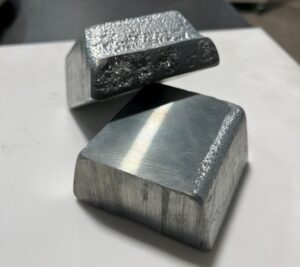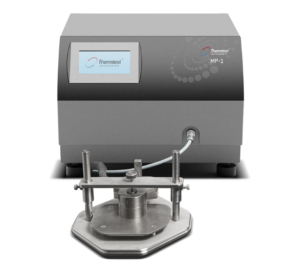In this application, we will be exploring the thermal conductivity of zinc. Zinc is an abundant and versatile element belonging to the transition metal family. Known to be moderately soft, ductile and malleable, zinc has broad applications in many industries including construction, automotive and electronics. Therefore, zinc is an essential material in a variety of industries today. Understanding the thermophysical properties of a material is essential for many different applications. For example, the technology industry may be interested in the thermal management of electronic devices. In this application, we will be exploring the Transient Plane Source (TPS) method using the Measurement Platform (MP-1) to measure zinc.
One sample of zinc was measured for thermal conductivity (W/m·K), thermal diffusivity (mm2/s), volumetric specific heat (MJ/m3K) and thermal effusivity (W√s/(m²K)) using the MP-1 with the TPS Method: Standard Module.
Zinc is a naturally abundant metallic element. Compared to other transition metals zinc is moderately soft and malleable. Due to this zinc may be too soft for certain applications. However, it was discovered that zinc can form strong alloys with other metals such as copper to form brass. Zinc also reacts very little with the atmosphere allowing it to withstand corrosion and rust better than other metals. This is because zinc forms an oxide layer on its surface which protects the metal from corrosion. Because of this, other metals are frequently galvanized or plated with zinc for protection.
The physical properties of zinc, including its low melting point and its hexagonal crystal structure allow for versatile use of this metal in plastics, rubber and paint. The cheap cost, high abundance and moderate electrical conductivity of zinc mean it can be used in a broad range of industries.

Figure 1. Zinc Sample
The MP-1 is designed to test the absolute thermal conductivity, thermal diffusivity and specific heat of solids, liquids, pastes and powders with the powerful combination of the transient plane source (TPS, ISO 22007-2) and transient hot-wire (THW, ASTM D7896-19) methods.
The MP-1 with TPS Standard Module is used to measure the average or bulk thermal conductivity and thermal diffusivity of isotropic materials.

Figure 2. Measurement Platform 1 (MP-1)
To measure the thermal conductivity of zinc using the TPS standard method, two pieces of zinc are placed on top of one another in a symmetric configuration with the TPS sensor sandwiched in the middle. The sensor will act a both a heat source and a resistance meter to the sample. The intelligent Transient Plane Source (iTransient) application was used to determine the optimal test parameters for the measurements.
Zinc is most often used in applications where chemical resistance and conductivity is required. One major application of zinc is using it to galvanize other metals such as iron or steel to prevent rust. Galvanized metals like steel are used for car bodies, street posts, safety barricades and bridges. Zinc can also be used in making alloys of brass or die-casting. Die-casting is an important application for hardware, electrical and automobile industries. Zinc is a durable metal. However, due to its low melting point compared to other metals it is malleable under the influence of heat, allowing it to be formed, stretched and compressed without breaking. Zinc is also abundant in nature compared to other metals making zinc an ideal metal for a variety of applications.
Zinc was measured for thermal conductivity (W/(m·K)), thermal diffusivity (mm²/s), and volumetric specific heat (MJ/(m³K)) with the MP-1 TPS Method. This was done using the symmetric configuration and the standard 10 mm radius double spiral TPS sensor (4617-1). Optimal measurement parameters of 3s and 2000mW were determined using the proprietary iTransient application.
Table 1. Thermophysical measurements of zinc at room temperature.
| Temperature (°C) | Thermal Conductivity W/(m·K) | Thermal Diffusivity mm²/s | Volumetric Specific Heat MJ/(m³K) |
| 26 | 129.661 | 45.439 | 2.853 |
| 129.368 | 46.179 | 2.801 | |
| 130.726 | 44.741 | 2.922 | |
| 129.620 | 45.428 | 2.853 | |
| 129.975 | 45.388 | 2.864 | |
| Mean (W/m·K) | 129.870 | 45.435 | 2.859 |
| Standard Deviation | 0.525 | 0.509 | 0.043 |
| %RSD | 0.4 | 1.1 | 1.5 |
The unique characteristics of flexibility, conduction, and resistance to atmospheric corrosion make zinc a very useful and versatile transition metal. In this application we investigated the thermal properties of zinc and found that it was a good conductor with thermal conductivity of 129.87 W/m·K.
Cverna, F. (2002). Thermal Properties of Metals. In Thermal properties of metals: ASM ready reference (p. 480)., ASM International.
Porter, F. (1991). Zinc handbook: Properties, processing, and use in design. M. Dekker.
Shibli, S. M. A., Meena, B. N., & Remya, R. (2014). A review on recent approaches in the field of hot dip zinc galvanizing process. Surface and Coatings Technology, 262, 210–215. https://doi.org/10.1016/j.surfcoat.2014.12.054
Wang, F., Borodin, O., Gao, T., Fan, X., Sun, W., Han, F., Faraone, A., Dura, J. A., Xu, K., & Wang, C. (2018). Highly reversible zinc metal anode for aqueous batteries. Nature Materials, 17(6), 543–549. https://doi.org/10.1038/s41563-018-0063-z
Zhou, Y., Dong, Z.-Y., Hsieh, W.-P., Goncharov, A. F., & Chen, X.-J. (2022). Thermal conductivity of materials under pressure. Nature Reviews Physics, 4(5), 319–335. https://doi.org/10.1038/s42254-022-00423-9